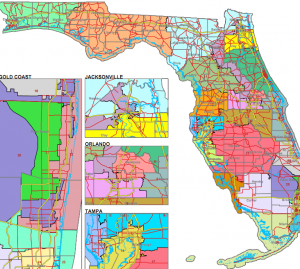New maps for the Legislature and the state’s congressional delegation passed three House panels along party lines Monday as the Senate Democratic leader unveiled her proposal for the once-a-decade redistricting process.
The House subcommittees tasked with drawing lines for the House and Congress each approved three alternatives for those plans, set to be considered by the House Redistricting Committee later this month. The subcommittee set up to address the Senate maps approved the upper chamber’s working version of the plan.
Leaders in both the House and Senate have said they have agreed to essentially pass each other’s maps for their respective chambers.
The congressional plans all passed on party-line votes after some of the strongest Democratic pushback so far in the process. Members of the outnumbered minority caucus argued against passing maps that had not been more thoroughly vetted by the public. Many of the speakers at public hearings across the state last summer complained bitterly that lawmakers didn’t present any options for them to comment on.
“These are the maps that I think they were asking for,” said Rep. Dwayne Taylor, D-Daytona Beach. “And I don’t believe we can have too much public participation.”
Republicans shot back that time is running short to approve the maps ahead of primaries set for this summer, and contending that the public hearings served their purpose by getting comments on the front end of the process.
“It’s just astounding to me how much public input is included in these maps,” said Rep. Kathleen Passidomo, R-Naples.
Jim Roach, a congressional candidate from Southwest Florida, said the new maps would tilt heavily against Democrats. But Republicans said they didn’t consider politics in crafting the plans, following the new redistricting standards approved by voters last year.
Maps for the House itself also passed on a nearly party-line vote, with Democratic Rep. Daphne Campbell of Miami joining that subcommittee’s GOP majority in supporting the plan. Campbell had a bitter falling-out with some Democratic colleagues last year over an abortion bill.
The GOP also touted the measures for being more compact and splitting fewer cities and counties than the current map. After a series of amendments, for example, one plan for the House map would reduce the number of split counties from 46 to 30 and the number of divided cities from 170 to 91.
Meanwhile, Senate Minority Leader Nan Rich introduced Democratic alternatives to Senate Republicans’ plans for redrawing the political boundaries for her chamber and for Congress. Rich, D-Weston, declined to discuss the maps in great detail because she said the analysis on the maps was not complete.
“The Democratic maps reconcile the Voting Rights Act and the redistricting requirements in the Florida Constitution,” she told reporters.
Rich also pointedly noted that she did not speak with her members about the maps — a step that Democrats criticized Republicans for during the drawing of their maps.
But Rich’s map was bound to draw controversy from within her own party. The map would radically alter one of the most controversial districts in the U.S. House, currently held by Democratic Congresswoman Corrine Brown. Instead of snaking from Jacksonville to Orlando, the district would turn west at Palatka and take in much of Gainesville. It also confines congressional seats to one side of Tampa Bay or another, something that Republicans have argued could run afoul of the Voting Rights Act.
In the Senate, the Northeast Florida seat currently held by Sen. Audrey Gibson, D-Jacksonville, would become far more compact. Surrounding districts, including a coastal one represented by Sen. John Thrasher, R-St. Augustine, would be completely reconfigured. The plan would also shift lines dramatically in several other places, including Southeast Florida.
By Brandon Larrabee



